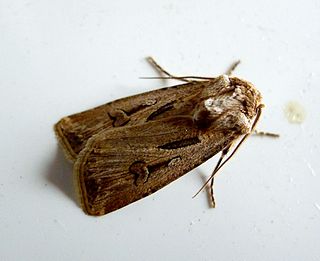
The heart and club is a moth of the family Noctuidae. It is distributed throughout the Palearctic realm.

The heart and dart is a moth of the family Noctuidae. The species was first described by Carl Linnaeus in his 1758 10th edition of Systema Naturae. A familiar moth to many, it is considered one of the most common of the European region. It occurs throughout the Palearctic realm from Ireland to Japan.

Agrotis is a genus of moths of the family Noctuidae. The genus was erected by Ferdinand Ochsenheimer in 1816. A number of the species of this genus are extinct.

Agrotis ipsilon, the dark sword-grass, black cutworm, greasy cutworm, floodplain cutworm or ipsilon dart, is a small noctuid moth found worldwide. The moth gets its scientific name from black markings on its forewings shaped like the letter "Y" or the Greek letter upsilon. The larvae are known as "cutworms" because they cut plants and other crops. The larvae are serious agricultural pests and feed on nearly all varieties of vegetables and many important grains.

Agrotis puta, the shuttle-shaped dart, is a moth of the family Noctuidae. The species was first described by Jacob Hübner in 1803. It is common in the western part of Europe, but is also found in southern and central Europe, as well as North Africa and the Middle East.

Agrotis vetusta, the old man dart, spotted-legged cutworm or muted dart is a moth of the family Noctuidae. The species was first described by Francis Walker in 1865. It is found in North America, from southern Alaska to Nova Scotia, southward into Mexico.

Agrotis ripae, the sand dart, is a moth of the family Noctuidae. The species was first described by Jacob Hübner in 1823. It is found in western Europe and North Africa and extends east across the Palearctic to steppe areas in Russia, Mongolia and Siberia.

Agrotis vestigialis, the archer's dart, is a moth of the family Noctuidae. The species was first described by Johann Siegfried Hufnagel in 1766. It is found in most of the Palearctic realm from Ireland east, through to Russia, Siberia, the Altai mountains and the Amur region, and is also present in the Mediterranean Basin. It is absent from the north of Finland and Norway.

Agrotis vancouverensis, the Vancouver dart, is a moth of the family Noctuidae. The species was first described by Augustus Radcliffe Grote in 1873. It is found in the Pacific Northwest of North America and is common west of the Cascade Mountains.

Agrotis spinifera, or Gregson's dart, is a moth of the family Noctuidae. The species was first described by Jacob Hübner in 1808. It is found in southern Europe, Arabia to southern Africa, Madagascar, Turkey, Iraq, Iran, Afghanistan, Pakistan, Kashmir, India to Myanmar and Sri Lanka.

Agrotis bigramma, the great dart, is a moth of the family Noctuidae. The species was first described by Eugenius Johann Christoph Esper in 1790. It is found from along the southern shores of the Baltic Sea to China, the Levant and North Africa. Migrants have been reported as far west as Great Britain with three in one trap at St Agnes, Isles of Scilly on 10 August 1997.

Agrotis graslini, or Woods's dart, is a moth of the family Noctuidae. The species was first described by Jules Pierre Rambur in 1848. It is known from coastal dunes in the western Mediterranean region. It was found on Jersey in 2001. Further investigations revealed that the species had been present there since at least 1995.
Agrotis buchholzi, or Buchholz's dart moth, is a species of cutworm or dart moth in the family Noctuidae. It was first described by William Barnes and Foster Hendrickson Benjamin in 1929 and it is found in North America.











